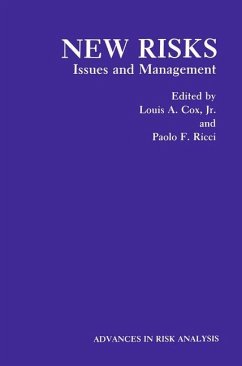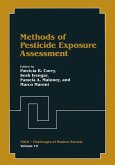New Risks: Issues and Management
Herausgegeben:Cox, Louis A.; Ricci, Paolo F.
New Risks: Issues and Management
Herausgegeben:Cox, Louis A.; Ricci, Paolo F.
- Broschiertes Buch
- Merkliste
- Auf die Merkliste
- Bewerten Bewerten
- Teilen
- Produkt teilen
- Produkterinnerung
- Produkterinnerung
This volume contains the proceedings of the 1986 annual meeting and conference of the Society for Risk Analysis. It provides a detailed view of both mature disciplines and emerging areas within the fields of health, safety, and environmental risk analysis as they existed in 1986. In selecting and organizing topics for this conference, we sought both (i) to identify and include new ideas and application areas that would be of lasting interest to risk analysts and to users of risk analysis results, and (ii) to include innovative methods and applications in established areas of risk analysis. In…mehr
Andere Kunden interessierten sich auch für
![The Analysis, Communication, and Perception of Risk The Analysis, Communication, and Perception of Risk]() The Analysis, Communication, and Perception of Risk121,99 €
The Analysis, Communication, and Perception of Risk121,99 €![Methods of Pesticide Exposure Assessment Methods of Pesticide Exposure Assessment]() Methods of Pesticide Exposure Assessment149,99 €
Methods of Pesticide Exposure Assessment149,99 €![Reproductive Toxicology Reproductive Toxicology]() Reproductive Toxicology112,99 €
Reproductive Toxicology112,99 €![Endocrine Disrupters Endocrine Disrupters]() Endocrine Disrupters112,99 €
Endocrine Disrupters112,99 €![Endocrine Disrupters Endocrine Disrupters]() Nicolopoulou-StamatiEndocrine Disrupters121,99 €
Nicolopoulou-StamatiEndocrine Disrupters121,99 €![Risk Analysis Risk Analysis]() Risk Analysis242,99 €
Risk Analysis242,99 €![Mercury as a Global Pollutant: Human Health Issues Mercury as a Global Pollutant: Human Health Issues]() Mercury as a Global Pollutant: Human Health Issues75,99 €
Mercury as a Global Pollutant: Human Health Issues75,99 €-
-
-
This volume contains the proceedings of the 1986 annual meeting and conference of the Society for Risk Analysis. It provides a detailed view of both mature disciplines and emerging areas within the fields of health, safety, and environmental risk analysis as they existed in 1986. In selecting and organizing topics for this conference, we sought both (i) to identify and include new ideas and application areas that would be of lasting interest to risk analysts and to users of risk analysis results, and (ii) to include innovative methods and applications in established areas of risk analysis. In the three years since the conference, many of the topics presented there for the first time to a broad risk analysis audience have become well developed-and sometimes hotly debated-areas of applied risk research. Several, such as the public health hazards from indoor air pollutants, radon in the home, high-voltage electric fields, and the AIDS epidemic, have been the subjects of headlines since 1986. Older areas, such as hazardous waste site ranking and remediation, air emissions dispersion modeling and exposure assessment, transportation safety, seismic and nuclear risk assessment, and occupational safety in the chemical industry, have continued to receive new treatments and to benefit from advances in quantitative risk assessment methods, as documented in the theoretical and methodological papers in this volume. A theme of the meeting was the importance of new technologies and the new and uncertain risks that they create.
Hinweis: Dieser Artikel kann nur an eine deutsche Lieferadresse ausgeliefert werden.
Hinweis: Dieser Artikel kann nur an eine deutsche Lieferadresse ausgeliefert werden.
Produktdetails
- Produktdetails
- Advances in Risk Analysis 6
- Verlag: Springer / Springer US / Springer, Berlin
- Artikelnr. des Verlages: 978-1-4899-0761-5
- Softcover reprint of the original 1st ed. 1990
- Seitenzahl: 732
- Erscheinungstermin: 8. Juni 2013
- Englisch
- Abmessung: 235mm x 155mm x 40mm
- Gewicht: 1104g
- ISBN-13: 9781489907615
- ISBN-10: 1489907610
- Artikelnr.: 39978042
- Herstellerkennzeichnung Die Herstellerinformationen sind derzeit nicht verfügbar.
- Advances in Risk Analysis 6
- Verlag: Springer / Springer US / Springer, Berlin
- Artikelnr. des Verlages: 978-1-4899-0761-5
- Softcover reprint of the original 1st ed. 1990
- Seitenzahl: 732
- Erscheinungstermin: 8. Juni 2013
- Englisch
- Abmessung: 235mm x 155mm x 40mm
- Gewicht: 1104g
- ISBN-13: 9781489907615
- ISBN-10: 1489907610
- Artikelnr.: 39978042
- Herstellerkennzeichnung Die Herstellerinformationen sind derzeit nicht verfügbar.
Risk Management for Controlling Pollution Liability in a Corporate Environment.- Corporate Management of Liability Risk.- The Independent Auditors' Assessment and Conveyance of Risk (Preliminary Results).- Strict Liability and Insurance Under Loss Misestimation.- Comparison of EPA, ILO, and World Bank Guidelines for Risk Identification, Assessment, and Management of Chemical Emergencies.- Decision Analysis in Environmental Risk Management: Applications to Acid Deposition and Air Toxics.- Causality in Toxicologic Risk Assessment and Risk Management.- Environmentally Induced Cancer: A Model for Estimating Excess Cancer Risks Based on a Two-Stage Model of Carcinogenesis.- Is the One-Hit Model of Carcinogenesis Conservative? Evidence from the National Toxicology Program's Bioassay Database.- Carcinogenicity Versus Acute Toxicity: Is There a Relationship?.- Incorporating More Science Into Cancer Dose-Response Extrapolations.- Parameters Involved in Risk Assessment for Environmental Release of Biotechnology Products.- Do Genetically Engineered Microorganisms Pose Risks to Ecosystems?.- Control of Microbial Pathogens in Poultry by Irradiation: Issues Related to Risks and Benefits.- Exposure Assessment for Sterilized Medical Devices: Implications for Microbiological Risk Analysis.- Risks in New Technologies - Controlling Toxic and Hazardous Gas Releases During Photovoltaic Cell Manufacture.- Application of Systems Analysis Techniques to Vulnerability Studies of Complex Installations.- Seismic Hazard in the Eastern United States: Bounding the Uncertainty.- Thinking the Unthinkable: Preparing for Global Disaster.- Risk Aversion in Agricultural Policy Analysis: A Closer Look at Meaning, Modeling, and Measurement.- Evaluating Risks to Agricultural Production from AcidDeposition.- Economic Principles of Risk Management in Production.- Assessing Risk from Dermal Exposure at Hazardous Waste Sites.- Bioaccumulation of TCDD in Lake Ontario Fish: Laboratory and Field Studies in Support of Hazardous Waste Landfill Risk Assessments.- Risk Assessment of Indoor Air Pollution by Termiticides.- Fuzzy Risk Analysis: Theory and Application.- Assessment of the Acceptability of the Proposals for a Fixed Link Across the English Channel.- Risk Assessment and Management: A Regional Approach.- Scientific and Technological Inputs to Nonroutine Decision Making by Three Groups: Scientists, Government Officials, Corporate Managers.- Confidence in Technologies: Interaction Between Publics and Industries.- Ritualism in Communicating Risk Information.- Summary of Panel Discussion on "The Role of Private and Public Sector Insurance and Compensation for Environmental Pollution".- Risk Management Through Market Incentives: Liability and Insurance.- A Comparison of the Human Exposure Model and the Air Emissions Risk Assessment Model.- Comparisons Between Desktop Dispersion Calculations and Computerized Air Dispersion Model Results When Results Are to Be Used in a Risk Assessment.- Livermore Risk Analysis Methodology: A Structured Decision Analytic Tool for Information Systems Risk Management.- LAVA: A Conceptual Framework for Automated Risk Analysis.- A Probabilistic Risk Assessment Program for Analyzing Security Risks.- A General Purpose Computer Shell for Risk Analysis.- A Preliminary Model of Radon Exposure.- Power-Frequency Fields: Risk Without Measure.- Computer Security Risk Analysis.- Diffuse Risks from Adversarial Sources: An Emerging Field of Risk Analysis.- Uncertainty and Variability in Environmental Risk Assessment: A Framework for Analysis.- AnExperiment in Combining Estimates of Uncertainty.- Linear-Nonparametric Low-Dose Disease Risk Estimation.- Methods Used in Probabilistic Risk Assessment for Uncertainty and Sensitivity Analysis.- Can We Bring Quality of Management into PRAs?.- Studies with a New Risk Reduction Model.- Hits on MRS.- A Psychological Perspective on Accident Evolutions and How to Arrest Them in Nuclear Power Plants.- Chernobyl Accident - Emergency Monitoring and Protection Measures in Poland.- The Accident at Chernobyl: A Report on Risk Management at a Local Hot Spot in West Germany.- The Comparative Ranking of Risks.- Getting to Maybe: Implied Principles of Trust and Consent in Two Massachusetts Acts.- Coping with Scientific and Technological Uncertainty: Federal Policy Anlaysis for Nonroutine Decisions.- Signal Detection and Perceived Risks: Homeowner Responses to Radon Risk Information.- Role of Publicity in Three Risk Management Decisions: Ethylene Dibromide as a Pesticide, Dioxin in Times Beach, and Screening Mammography.- An Extension of the Coverage-Attitude Hypothesis: Coverage of Technological and Environmental Hazards in Dutch Newspapers and Readers' Reactions.- Contrasting Risk Communication Tasks and Objectives for Superfund Sites, Underground Storage Tanks, and Biotechnology Field Tests.- Communicating Risk: Factors Affecting Community Acceptance of Information.- AIDS: Risks and Public Policies.- The Healthy Worker Effect: The Need to Reevaluate a Broad Spectrum of Occupational Risks.- Cultural Values Affecting Risk Perception: Individualism and the Perception of Toxicological Risks.- Are Twenty-Fold Differences in "Lifesaving" Costs Justified?: A Psychometric Study of the Relative Value Placed on Preventing Deaths from Programs Addressing Different Hazards.- TheNature of PRA for the Chemical Industry.- Risk Uncertainties in Public Sector Safety Decisions: Assessment Methods and Management Implications.- Assessment of Risks from Acute Hazards at Monsanto.- Differences Between Industries in the Definition of Acceptable Risk.- Risk Education and Hazard Management in the Workplace: The Role of Workers' and Executives' Social Relations.- Consumer Response to Food Risk Information: Demographic Differences.- Estimating Fatality Reductions from Increased Safety Belt Use.- Are Special Trains Really Safer?.- Comparison of Risks from Ocean-Based and Land-Based Incineration of Hazardous Wastes.- Carcinogenesis Risk Assessment of Two-Carbon Alkylating Agents Using Dynamic Simulation of Absorption and Metabolism.- Author Index.
Risk Management for Controlling Pollution Liability in a Corporate Environment.- Corporate Management of Liability Risk.- The Independent Auditors' Assessment and Conveyance of Risk (Preliminary Results).- Strict Liability and Insurance Under Loss Misestimation.- Comparison of EPA, ILO, and World Bank Guidelines for Risk Identification, Assessment, and Management of Chemical Emergencies.- Decision Analysis in Environmental Risk Management: Applications to Acid Deposition and Air Toxics.- Causality in Toxicologic Risk Assessment and Risk Management.- Environmentally Induced Cancer: A Model for Estimating Excess Cancer Risks Based on a Two-Stage Model of Carcinogenesis.- Is the One-Hit Model of Carcinogenesis Conservative? Evidence from the National Toxicology Program's Bioassay Database.- Carcinogenicity Versus Acute Toxicity: Is There a Relationship?.- Incorporating More Science Into Cancer Dose-Response Extrapolations.- Parameters Involved in Risk Assessment for Environmental Release of Biotechnology Products.- Do Genetically Engineered Microorganisms Pose Risks to Ecosystems?.- Control of Microbial Pathogens in Poultry by Irradiation: Issues Related to Risks and Benefits.- Exposure Assessment for Sterilized Medical Devices: Implications for Microbiological Risk Analysis.- Risks in New Technologies - Controlling Toxic and Hazardous Gas Releases During Photovoltaic Cell Manufacture.- Application of Systems Analysis Techniques to Vulnerability Studies of Complex Installations.- Seismic Hazard in the Eastern United States: Bounding the Uncertainty.- Thinking the Unthinkable: Preparing for Global Disaster.- Risk Aversion in Agricultural Policy Analysis: A Closer Look at Meaning, Modeling, and Measurement.- Evaluating Risks to Agricultural Production from AcidDeposition.- Economic Principles of Risk Management in Production.- Assessing Risk from Dermal Exposure at Hazardous Waste Sites.- Bioaccumulation of TCDD in Lake Ontario Fish: Laboratory and Field Studies in Support of Hazardous Waste Landfill Risk Assessments.- Risk Assessment of Indoor Air Pollution by Termiticides.- Fuzzy Risk Analysis: Theory and Application.- Assessment of the Acceptability of the Proposals for a Fixed Link Across the English Channel.- Risk Assessment and Management: A Regional Approach.- Scientific and Technological Inputs to Nonroutine Decision Making by Three Groups: Scientists, Government Officials, Corporate Managers.- Confidence in Technologies: Interaction Between Publics and Industries.- Ritualism in Communicating Risk Information.- Summary of Panel Discussion on "The Role of Private and Public Sector Insurance and Compensation for Environmental Pollution".- Risk Management Through Market Incentives: Liability and Insurance.- A Comparison of the Human Exposure Model and the Air Emissions Risk Assessment Model.- Comparisons Between Desktop Dispersion Calculations and Computerized Air Dispersion Model Results When Results Are to Be Used in a Risk Assessment.- Livermore Risk Analysis Methodology: A Structured Decision Analytic Tool for Information Systems Risk Management.- LAVA: A Conceptual Framework for Automated Risk Analysis.- A Probabilistic Risk Assessment Program for Analyzing Security Risks.- A General Purpose Computer Shell for Risk Analysis.- A Preliminary Model of Radon Exposure.- Power-Frequency Fields: Risk Without Measure.- Computer Security Risk Analysis.- Diffuse Risks from Adversarial Sources: An Emerging Field of Risk Analysis.- Uncertainty and Variability in Environmental Risk Assessment: A Framework for Analysis.- AnExperiment in Combining Estimates of Uncertainty.- Linear-Nonparametric Low-Dose Disease Risk Estimation.- Methods Used in Probabilistic Risk Assessment for Uncertainty and Sensitivity Analysis.- Can We Bring Quality of Management into PRAs?.- Studies with a New Risk Reduction Model.- Hits on MRS.- A Psychological Perspective on Accident Evolutions and How to Arrest Them in Nuclear Power Plants.- Chernobyl Accident - Emergency Monitoring and Protection Measures in Poland.- The Accident at Chernobyl: A Report on Risk Management at a Local Hot Spot in West Germany.- The Comparative Ranking of Risks.- Getting to Maybe: Implied Principles of Trust and Consent in Two Massachusetts Acts.- Coping with Scientific and Technological Uncertainty: Federal Policy Anlaysis for Nonroutine Decisions.- Signal Detection and Perceived Risks: Homeowner Responses to Radon Risk Information.- Role of Publicity in Three Risk Management Decisions: Ethylene Dibromide as a Pesticide, Dioxin in Times Beach, and Screening Mammography.- An Extension of the Coverage-Attitude Hypothesis: Coverage of Technological and Environmental Hazards in Dutch Newspapers and Readers' Reactions.- Contrasting Risk Communication Tasks and Objectives for Superfund Sites, Underground Storage Tanks, and Biotechnology Field Tests.- Communicating Risk: Factors Affecting Community Acceptance of Information.- AIDS: Risks and Public Policies.- The Healthy Worker Effect: The Need to Reevaluate a Broad Spectrum of Occupational Risks.- Cultural Values Affecting Risk Perception: Individualism and the Perception of Toxicological Risks.- Are Twenty-Fold Differences in "Lifesaving" Costs Justified?: A Psychometric Study of the Relative Value Placed on Preventing Deaths from Programs Addressing Different Hazards.- TheNature of PRA for the Chemical Industry.- Risk Uncertainties in Public Sector Safety Decisions: Assessment Methods and Management Implications.- Assessment of Risks from Acute Hazards at Monsanto.- Differences Between Industries in the Definition of Acceptable Risk.- Risk Education and Hazard Management in the Workplace: The Role of Workers' and Executives' Social Relations.- Consumer Response to Food Risk Information: Demographic Differences.- Estimating Fatality Reductions from Increased Safety Belt Use.- Are Special Trains Really Safer?.- Comparison of Risks from Ocean-Based and Land-Based Incineration of Hazardous Wastes.- Carcinogenesis Risk Assessment of Two-Carbon Alkylating Agents Using Dynamic Simulation of Absorption and Metabolism.- Author Index.








